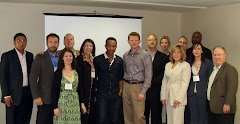This panel featured Patrick Crane, CMO of LinkedIn; Joel York, CMO, Xignite; and Michael Terpin, CEO, SocialRadi.us.
The digital world is in flux. While Yahoo! closed down Geocities last week and SecondLife fizzled out to become the Milli Vanilli of the social media revolution, Facebook is getting millions of new users each day and Twitter is getting boosted by the Oprah effect.
The conversation opened by inviting the three panelists to share the top 3 general trends they’re seeing in the digital space.
Patrick:
- Conversational Marketing – It’s always been happening, but we’re only now able to track it and get involved. Some of the more thoughtful brands are using the technology in exciting ways, such as Mazda’s consumer polls on LinkedIn.
- Putting faces to brands – Employees are already becoming the voice of your brand.
- Re-targeting – Retargeting is placing cookies on visitors to a site and then matching ad content to the types of sites they visit afterwards. It’s an a great way to tailor advertising.
Joel:
- More convergence and opportunities across media – We’re seeing mobile apps, and online video and television are already merging. You’ll be able to do much more to reach across all sorts of media in the future.
- Search – Search has a bigger future than just Google – we’re about to see a revolution
- Accessibility – Five years ago anybody could put up a website. Now anyone can join a social network or post a video. Marketing on the internet comes down to content and links, which go hand-in-hand.
Michael:
- Convergence of Lead Generation companies and Social is just around the corner.
- Content-based SEO strategies – People are learning to make the investment in content and accept the fact that payoff is in the long run, as SEO builds each link’s reputation.
- The coming of mobile social – As more and more plans make it more reasonable for more people to get high-speed access on their phones, there will be a huge spike in mobile social.
The question was then posed, “Do marketers need websites anymore, or are social networks enough?”
Joel said that it’s a bad idea to treat your website as a separate piece, and to instead think about it as one large network. The website may become the central hub of the conversation, but you’ll want to spread it out.
“Don’t drop your website or you’ll lose all your SEO,” warned Michael. Instead, create a network where all your social media is living out there and pointing back to you.
Next question up was “Do organizations need a mobile application strategy?”
It’s a lot like having a widget strategy a year ago, said Joel. If you want to do it, you need to make sure you make useful apps, and that they’re supported throughout your network. There are lots of bad apps out there and they make their brands look bad.
Patrick warned that the strategy of only using social platforms to broadcast your message is going to die, since you need a holistic way to track issues. Social networking is a great way to track issues ahead of time, and Patrick said that companies will thrive when they engage.
Michael predicted that this time next year there will be over 100 million users on Twitter. “It’s an amazing reporting tool,” he said. “If you went on Google five minutes after yesterday’s earthquake in California, you had nothing. If you went on Twitter, you already had hundreds of posts from around the region.”
Next question: “What are some of the interesting uses of Twitter?”
The panel agreed that crisis and issues management was a place where Twitter was giving organizations an upper-hand. But Michael added that Twitter is also making employees the face of your brand, as people are broadcasting their insider’s view of major organizations and affecting outsider’s perceptions.
Final question: “There’s a lot going on out there, so how do you guys keep up? What’s your secret weapon?”
Patrick: “We live it. We have a lot of young employees who are out there in it every day.”
Joel: “Listen to the customers. There’s always technology out there but you need to know if your audience is using it, or if they ever will.
Michael: “I use Twitter and Facebook. That’s where I spot things first.”
Subscribe to:
Post Comments (Atom)







No comments:
Post a Comment